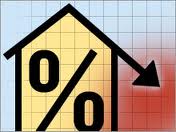 The way a mortgage usually is broken down is into two parts: the interest which you pay the lender each month, and the amount which would reduce the balance of the principle, which is referred to as the amortization of principal. The basic idea is that there is a specific amount which will pay off the loan completely at the end of the loan term. If you pay less than that amount, you will have a balance at the end of the term, and if you pay more than that amount, you’ll pay off the loan earlier than the term.
The way a mortgage usually is broken down is into two parts: the interest which you pay the lender each month, and the amount which would reduce the balance of the principle, which is referred to as the amortization of principal. The basic idea is that there is a specific amount which will pay off the loan completely at the end of the loan term. If you pay less than that amount, you will have a balance at the end of the term, and if you pay more than that amount, you’ll pay off the loan earlier than the term.
To give a better example, if you have a 30 year mortgage and that your monthly payment is $1,200. $1,000 of that is due the lender, and the other $200 goes to reducing the balance of the mortgage. If you pay just the $1,000, then your balance doesn’t change; you’re basically just paying the interest of the loan, and therefore it’s called an “interest only loan”.
In a negative amortizing mortgage, you are paying less than the interest due on the loan, and the balance of that interest is added to the loan. Using the example above, if you only paid $800 a month, then the other $200 in interest that you owe each month would be added to your loan amount and would be due at the end of the 30 years.
Normally, the reason behind a negative amortizing mortgage would be to reduce the monthly payments at the beginning period of the loan to make the payments more manageable for the borrower. People have used this type of arrangement in fixed rate mortgages (FRMs) and in adjustable rate mortgages (ARMs). With FRMs, this is usually referred to as GPM (graduated payment mortgage) since you will have to increase the size of your payments later during the life of the loan to make up for the smaller payments in the beginning of the loan. With ARMs specifically, some may choose to do this in order to reduce the likelihood of “payment shock” – this refers to unexpected, large increases in the amount of payments.
Also called “neg-am” loans, these were advertised by a lot of banks, lenders, and brokers as low payment mortgages, and sometimes the borrower was not fully aware of how the payments needed to change later during the life of the loan. This created complications for a lot of borrowers leading to refinancing, defaulting on loans, and ultimately foreclosures. In many cases, these were used because this was the only way that some borrowers could qualify for a mortgage.
Used properly “neg-am” mortgages can be a good way to get into a home without breaking the bank. The key is making sure that you understand the payment schedule and the risks associated, and make plans to be able to increase the loan payments over the life of the loan. With proper care, these are very useful mortgage arrangements, but should only be used by those who fully understand them.
Written by JR Olson for the team at paydaycashadvanceloans.biz who can find you money for your mortgage as soon as possible.



